The United Nations takes over.....Later Years
One year into the UNFICYP mandate, the UN General Secretary felt that, "little progress had been made with the main unresolved issues despite its persistent efforts and repeated appeals".........the taking of hostages, freedom of movement, economic restrictions and the removal of fortifications.
The every day task, "to use UNFICYP's best efforts to prevent a recurrence of fighting and, as necessary, to contribute to the maintenance and restoration of law and order and a return to normal conditions" continued.
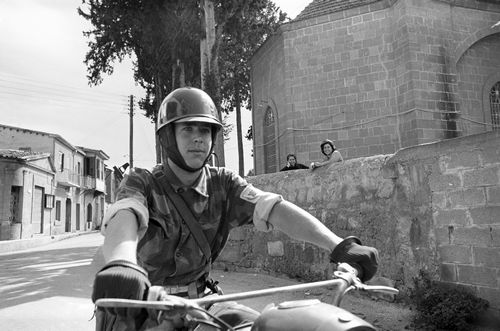
A Finnish soldier patrols 'The Green Line' running through the village of Omorfita, on the outskirts of Nicosia.......dated April 1965
This village was the scene of major conflict in 1963/64
Freedom of movement was an especially difficult issue for all sides, including the UN. A large number of locations in Cyprus were initially declared (by the Cyprus Government) as "out of bounds" to the UN.
The Turkish Cypriots were often deprived of free movement, not by the Greek Cypriots, but by their own leadership. A £1 fine would be imposed for, "those who will come into contact with Greek Cypriots for any official work."
A £25 fine, imprisonment or whipping faced those who, "enter the Greek Cypriot sector for promenade, friendly association or amusement."
Click this link to view the full range of this regulation (an extract from the UN Secretary General's Report......S/6102)
On the 23rd July 1966 an incident began in the village of Melouseia (often spelled Melousha in UN reports). It appears that a Cyprus police vehicle drove through the village in an "apparently belligerent manner" and then set up a road block on the eastern edge. Turkish Cypriot fighters from the village and surrounding areas moved to occupy their defensive positions and prevented any attempt by the police vehicle from re-entering the village.
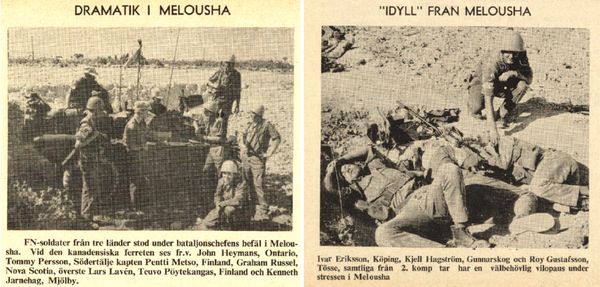
Images from the 'Blue Beret' magazine dated 3rd August 1966.........click this link or the image for a larger image
The UN were informed that the National Guard intended to attack the village. A small force of Swedish UN soldiers was immediately sent to Melouseia and while UN HQ "played for time" they were reinforced by Danish and Finnish infantry as well as Canadian artillery (the resulting UN force was larger than the attacking National Guard).
General Grivas was informed that any attack on the Turkish village would be met by force if his soldiers approached closer than 200m from the UN positions.
The National Guard Chief of Staff contacted the local commander and the advance was halted, it is reported, when they were 250m away from UN positions.
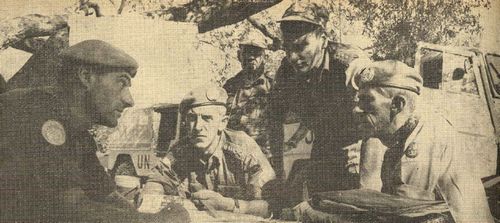
COMBINED OPERATION —On 23/24 July, an Inter-communal incident at Melousha threatened to take on more serious proportions. UNFICYP quickly moved in to interpose itself and avoid a possible recurrence of fighting. In this operation, within UNFICYP Famagusta Zone where the Swedish Contingent is deployed, UNFICYP men belonging to SWEDCON, FINCON and CANCON worked together as a combined operation under the Zone command.
(Image and text from the 'Blue Beret' magazine dated 3rd August 1966)
A serious intercommunal incident occurred at Mari in April 1967 when it was reported that a Cyprus National Guard armoured car was fired upon by Turkish Cypriot positions overlooking the main road between Limassol and Nicosia.
Fire was returned by the National Guard with machine guns and mortar rounds.
Eventually, after further outbreaks of shooting, British and Swedish UN troops positioned themselves between the two sides and hoisted the UN flag.
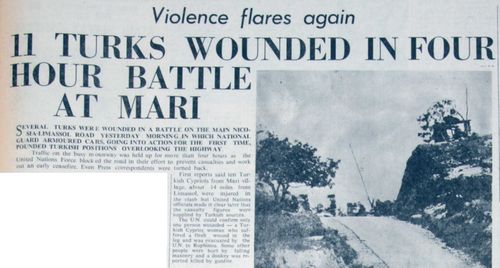
It is believed that the casualty figures were exaggerated as the UN could only confirm one Turkish Cypriot lady with a minor leg wound
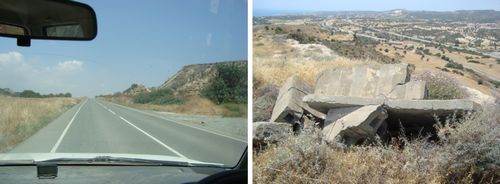
Author's note: In 1973, when driving to the ESBA every weekend, I would always wave to the UN position that was still on the edge of the ridge
In 2014 I went up to the location to discover the remains of the OP
In July and August 1967 a series of abductions and muders took place which paralysed life in the Paphos District. Farmers would not venture into their fields and escorted convoys were necessary for any movement to take place. No specific reason for these senseless murders was ever discovered but following a number of meetings between the UN and village mukhtars, life returned to normal by the end of September.
Serious fighting in the Ayios Theodorous-Kophinou area in November 1967 brought Greece and Turkey to the brink of war.
In a situation similar to the earlier Mari incident, a Greek Cypriot police patrol was stopped and then fired upon as it attempted to drive through the Turkish Cypriot part of the village. The incident quickly escalated with the National Guard (controlled by General Grivas) fiercely engaging Turkish Cypriot positions in the area. This resulted in the deaths of 24 Turkish Cypriots and 2 Greek Cypriots.
Turkish jets began immediately to fly over Cyprus and troops were massed on the mainland Greek/Turkish border.
International pressure defused the crisis and General Grivas was ordered to return to Athens.
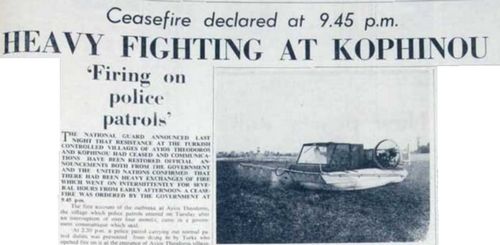
Headline from the Cyprus Mail dated November 16th 1967
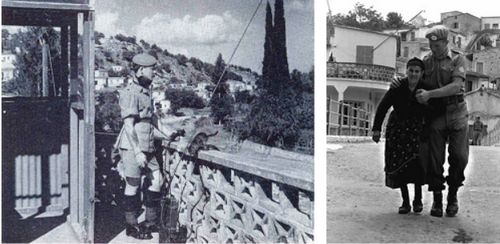
Following these events, UNFICYP maintained a strong presence in the village of Ayios Theodoros and at other locations in the surrounding area.
At the end of November, roofing and other building materials were supplied by the Government free of charge and the repairs to the two villages began immediately. The two communities of Ayios Theodoros began mingling as freely as before, meeting in their coffee-houses and even exchanging gifts.
However, the UN General Secretary's December 1967 report (S/8286) stated.........
"The recent events on the island and their very serious repercussions have shown how precarious the situation surrounding Cyprus remains and how easily and rapidly, in spite of the best efforts of UNFICYP, relatively small incidents can develop into an iminent threat to international peace".